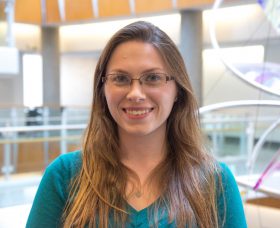Congratulations to our new PhDs
Congratulations to our new PhDs
Katelynn Koskie
Primary advisor: Dr. Mannie Liscum
Dissertation title: Investigating a hyper-phototropic phenotype in Arabidopsis thaliana and Zea mays
Optimal plant growth and development hinges on the plant’s ability to absorb sunlight. Because plants are sessile, they have evolved a variety of responses to maximize their photosynthetic light capture. One response, called phototropism, allows plants to bend toward or away from a directional light source via blue-light (BL) induced differential cell elongation. Phototropism is mediated by a family of membrane-bound, blue-light absorbing photoreceptors called the phototropins of which there are two members, phot1 and phot2. Koskie examined a gain-of-function mutant called phot1.PKD, that displays a hyper-phototropic phenotype. PHOT1/phot1.PKD mutant lines were used to test BL-induced responses, analyze the subcellular localization of phot1.PKD, and investigate the fitness benefits displayed in previous lines. In addition, to test fitness benefits in a crop species, maize lines containing this mutation were generated and tested in an outdoor field setting. Koskie coauthored a review of phototropism published in the Journal of Experimental Botany (2020;71,5:1652-1658).
Dr. Koskie will be moving to Vermont, where she will be working for a small biotechnology company.
Austin Lynn
Primary Advisor: Dr. Candi Galen
Dissertation title: Weed versus wildflower: mating system ecology in a Taraxacum native-exotic contact zone
In the genus Taraxacum (dandelions), self-incompatible and apomictic (clonally reproducing) species co-occur in the Rocky Mountain alpine habitats in central Colorado. Lynn explored how cross pollination from an invasive apomictic species (Taraxacum officinale) to a native sexual species (T. ceratophorum) might lead to inbreeding depression in the sexual species through the action of the mentor effect (induced selfing following heterospecific pollen delivery). He also explored how pollen grain morphological differences between these two dandelion species are driven by either sexual selection to increase the chance of adhering to a pollinator, or natural selection for the pollen grains to avoid being eaten. His findings were published in the American Journal of Botany (2020; 107,2:364-374) and Aquilegia (2018;42:23-26). His research was supported by a Planting Science: Digging Deeper NSF Fellowship and a Myrna P. Steinkamp Memorial Grant from the Colorado Native Plant Society as well as two travel awards.
“It has been wonderful to have Austin in my lab group,” said Galen. “His joy of all things green and chlorophyllous, his patience and enthusiasm as a mentor to countless undergraduate students, and his openness to embrace new ideas and approaches are a winning combination. But most of all, it is his sense of humor and his upbeat “can do” attitude that we will miss in the lab and the field, every day.”
Dr. Lynn hopes to continue research on North American dandelions, a group that has been largely ignored but is ripe for studies on the evolution of pollen morphology and mating system. His goal is to teach at a small liberal arts college where he can engage students in natural history and inquiry-based botany and ecology courses.
Anna Perinchery-Herman
Primary Advisor: Dr. Libby King
Dissertation Title: The genetic and physiological basis of total energy budget in different nutritional environments
Organisms need to adapt to dynamic environments over time. An organism consumes and stores a finite amount of resources that are used for all daily tasks. In order to survive and thrive, they must allocate these finite resources to different life history traits like reproduction or somatic growth. In order to understand this process, Perinchery-Herman examined the genetic and phenotypic variation in macromolecule content, estimated heritability for these phenotypes, and studied the effects of selection on macromolecule content. She presented her research at the 56th and 60th Annual Drosophila Conference, 2017 Evolution Conference, and the 2016 Allied Genetics Conference and is coauthor on a publication in the Proceedings of the Royal Society B: Biological Sciences (2017;284,1857).
“Anna is the first PhD student to graduate from my lab. I could not be more proud of all she has accomplished over the past several years,” said King. “Collaborating with her on her project has been such a valuable experience for me. I know she and I will continue to collaborate in the future, but I (and the rest of the lab) will really miss the enthusiasm and optimism that she brings with her wherever she goes.”
Dr. Perinchery-Herman moved to Arkansas, where she is pursuing a career in science education.
The Division also congratulates Angelynn Simenson, who will be graduating with a Master’s degree this semester.




